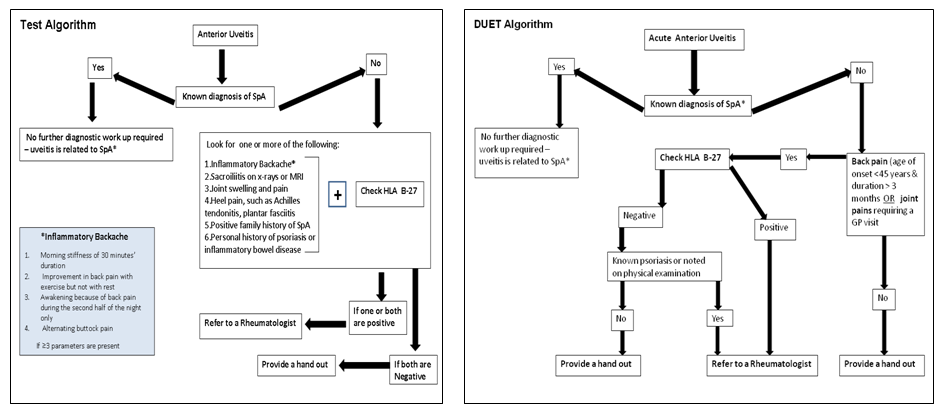Session Information
Session Type: Abstract Submissions (ACR)
Background/Purpose: The prevalence of mostly undiagnosed underlying Spondyloarthropathy (SpA) is more than 60% among patients presenting with acute anterior uveitis (AAU). To date, there are no formal guidelines or referral pathways for AAU patients developed or endorsed by any international or national societies. The objectives of our study were: (1) to investigate the prevalence of undiagnosed SpA in patients presenting with idiopathic AAU; (2) to develop and validate an assessment algorithm for referral from Ophthalmologists of appropriate AAU patients to Rheumatology that will aid the early diagnosis of the SpA
Methods: All consecutive patients attending emergency department of local ophthalmology hospital with AAU, but who did not have a known diagnosis of SpA, were eligible to partake in this study. Patients with any other known cause of AAU were excluded.
DEVELOPMENT COHORT: The rheumatologic referral was made as per a test algorithm (Figure-1), and those who did not require a referral, remained part of the study as a control group; these patients also underwent detailed rheumatologic evaluation.
VALIDATION COHORT: To confirm the findings from the development cohort, we recruited a validation cohort with similar entry and exclusion criteria. Algorithm version-1 (revised form of test algorithm which is now named the DUET algorithm, figure-1) was used in this cohort to identify patients requiring rheumatologic referral.
Results:
DEVELOPMENT COHORT: 104 consecutive patients from September 2011 through to June 2012 were recruited. However, 3 of these patients were lost to follow up prior to rheumatologic evaluation. After rheumatologic evaluation of the entire cohort (n=101), 41.6% (n=42) had undiagnosed SpA as per ASAS classification criteria. Our test algorithm was noted to have: sensitivity 100%, specificity 53.5%, PPV 61% and NPV 100%. Further regression analysis resulted in the development of the DUET algorithm which made the following improvements in the assessment of the development cohort: sensitivity 95%, specificity 98%, PPV 97.5%, NPV 96.6, positive LR 56.19, and negative LR 0.04.
VALIDATION COHORT:
To obtain a 95% confidence interval of at least as narrow as ±10% or ±8% for all the statistics, a sample size of 44 or 69 participants, respectively, was deemed sufficient. Hence, consecutive 74 idiopathic AAU patients were recruited from November 2012 through to April 2013, but 2 of these patients were lost to follow-up. After rheumatologic evaluation of the cohort (n=72), 40% (n=29) were diagnosed with SpA, with the following performance of DUET algorithm – sensitivity 96%, specificity 97%, PPV 96.5, NPV 97.6, positive likelihood ratio 41.5 and negative likelihood ratio of 0.03
Figure-1
Conclusion: Approximately 40% of patients presenting with idiopathic AAU have undiagnosed SpA. A simple to apply algorithm is described with excellent sensitivity and specificity.
Disclosure:
M. Haroon,
None;
M. A. O’Rourke,
None;
P. Ramasamy,
None;
C. Murphy,
None;
O. FitzGerald,
UCB, PFIZER, ABBOTT, ROCHE, MSD, BMS,
2,
Janssen Pharmaceutica Product, PFIZER, ABBOTT, ROCHE, BMS, MSD,
5,
Pfizer, ABBOTT, UCB, ROCHE, JANSSEN,
8.
« Back to 2013 ACR/ARHP Annual Meeting
ACR Meeting Abstracts - https://acrabstracts.org/abstract/a-novel-evidence-based-detection-of-undiagnosed-spondyloarthritis-in-patients-presenting-with-acute-anterior-uveitis-the-duet-dublin-uveitis-evaluation-tool-algorithm/

